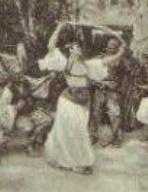About Scimitars (Swords)
Below you will find information on dancing with a scimitar or sword in bellydance.
Although belly dancing with a scimitar can only legitimatly be traced back to American roots. It became popular in the United States in the 1970's. Jamila Salimpour's troupe, Bal Anat used them as a prop, balanced on their head, as part of their routines for the California Rennaissance Fair. Jamila is reported to have gotten the idea from the famous (at least among belly dancers) painting of a Ghawazee by Jean Leon Gerome. This caught on with many soloists and troupes who continued to perform and teach Sword dances.
In the Middle East there is no such traditional dance that involves balancing the sword on the head, especially not as part of a raqs sharqi or raqs baladi type of performance. However the Middle East does have it's own history of sword dances ("Raqs as-Sayif"). Traditionally these dances are performed by men as a show of strength and military prowess. In Egypt men perform a sword dance they call "al-Ard", in Iran they call similar dance battles "Shamshir Bazi" (although "Raghs Shamshir" has become a more popular term), in Turkey they are called "kılıç dansı". Men all over the Middle East and North Africa have mock battle dances with swords and sticks and more recently with guns. These dances all are meant to practice skills for fighting and show off physical ability and skill with the weapon. The gun and rifle dances done today in the region are descendants of sword dance traditions that have evolved with the times.
Sword dances have been performed by bedouin women in North Africa, where it supposedly is an ancient skill. There are several examples of orientalist paintings and early photographs showing women dancing with swords. The paintings like all orientalist works may show fictional content but there is also the possibility that what they show has some truth to it as well. There are stories that among bedouin women the sword was used as a sign of carrying their husbands honour. Sometimes they would perform sword dances at weddings to bring good luck as well. Sword dances are still performed at some weddings but are usually performed by men.
A common story told about sword dances is that it was performed by slaves who would balance the sword on their heads as a way of saying "you may hold a sword over myhead, but I am free in my soul." This particular story seems unlikely as a slave having access to weopons seems unlikely for security reasons. Another story tells that Ghawazee dancers of Egypt would entertian the invading Turkish troupes and dance with their swords on their heads and then steal the swords. Supposedly the Sultan banned sword dancing because too many swords were being stolen in this fashion. Although this makes for an interesting story, I have yet to come across any records of there being any such bans in the Ottoman empire during the appropriate time periods.
It is entirely possible that some ghawazee, while entertaining the troups, thaught it would be cute to take the men's swords and dance with them. Especially considering that Egyptian women developed raqs al-assaya (cane dance) as a way of playfully mocking the men's tahtib (stick dance). It makes sense that someone using the same concept thought it would be cute to be playful with a sword.

